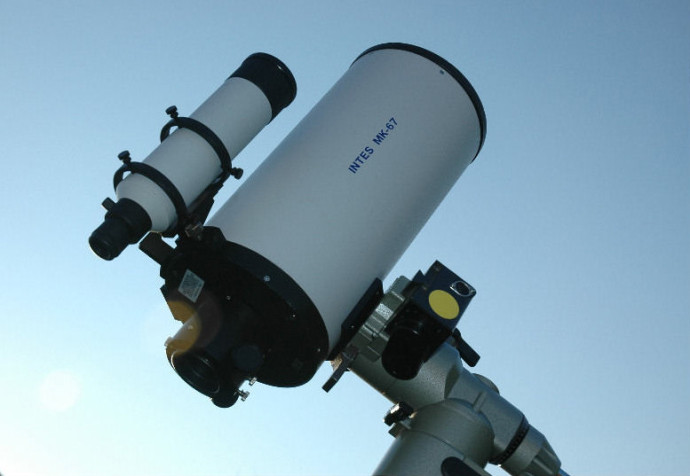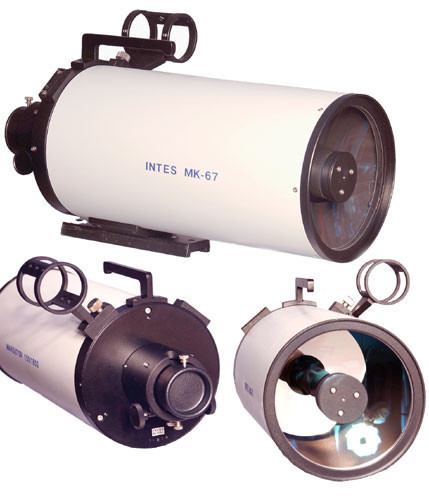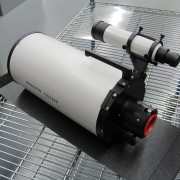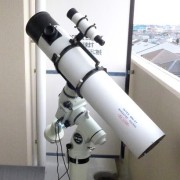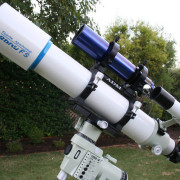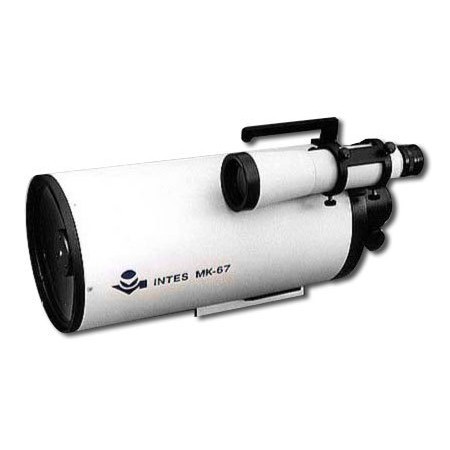INTES MK-67
Anno 2014
Il Maksutov-Cassegrain Intes MK-67 installato su una classica Vixen GP equatoriale.
Foto non dell'autore.
INTRODUZIONE
Quella dei maksutov è una specie che non sono mai riuscito ad amare. Tanto mi piace la loro logica quanto poi mi hanno quasi sempre tutti deluso un poco nell’utilizzo visuale, forse troppo abituato a rifrattori di buon livello.
Il primo vero maksutov che ebbi modo di usare, e che mi piacque tantissimo, era il vecchio Meade 178 che lavorava con una focale di 2700 mm circa ma aveva una ostruzione piuttosto elevata, superiore a 0,30 e quindi vicina a quella degli Schmidt Cassegrain tradizionali.
Poi sono passato attraverso tubi ottici realizzati da Zen, da Synta, e da altri, compresa appunto la Inets di questo articolo, che mi hanno un po’ tutti lasciato una sensazione di “vaghezza”, con la sola eccezione del Mirage SFT da 20 cm. (si veda il test su questo sito).
In effetti va detto che lo schema Maksutov abbraccia sottoschemi vari: il maksutov gregory, il maksutov-rumak, maksutov cassegrain.
L’INTES MK67 è un Maksutov-Cassegrain da 15 cm. di diametro e focale prossima a 1800 mm. per un rapporto focale di f12. Ostruzione generosa (superiore al 30%), costruzione spartana ma molto robusta, sistema di focheggiatura a pignone e cremagliera.
CARATTERISTICHE
Lo strumento è compatto ma molto pesante, decisamente più massiccio di uno Skywatcher di pari diametro ma schema ottico Maksutov-Gregory (che personalmente preferisco se è “a posto”). Costa decisamente tanto se viene paragonato alla concorrenza “cinese”, siamo a circa la metà e le prestazioni, onestamente, non sembrano essere migliori.
Il vero vantaggio di questo INTES è dato dalla possibilità di intervenire sulla collimazione del secondario, cosa preclusa nelle varianti Rumak e Gregory (che però sono solitamente meno ostruite).
TEST E CONFRONTI
Ho avuto modo, per diversi mesi (più di un anno) di usare in contemporanea il MK-67, un MN61 DX (sempre Intes ma con schema maksutov-newton e ostruzione pari a circa 0,19) e un Takahashi FS-102.
In campo planetario ho sempre trovato vincitore l’MN-61 a cui stava incollato l’FS-102 sia per dettaglio che per contrasto e capacità di reggere gli ingrandimenti. Non esisteva nessun dettaglio alla portata del MN-61 che non fosse visibile nel rifrattore apocromatico alla fluorite. Però, alcuni di questi dettagli (ad esempio alcuni festoni) risultavano meglio saturi nel 15 cm. e, a volte, anche di più veloce individuazione. In compenso il rifrattore esibiva, sempre e comunque, una immagine più “agreable”. Se l’MN-61 DX( specchi in Sitall e correzione dichiarata almeno a lambda/8) risultava lievemente superiore in quanto a prestazioni assolute in alta risoluzione sui pianeti e Luna, certo non si faceva amare per maneggevolezza e comodità di osservazione.
La versione maksutov-cassegrain non pareggiava il dettaglio del newton ed era meno inciso del rifrattore. In compenso era comodo da usare ma richiedeva un acclimatamento lungo (circa il doppio rispetto al mak-newton).
Ho finito per tenere l’FS-102 e vendere gli altri due.
Chi scrive che un maksutov da 150/1800 ha prestazioni superiori a un doppietto alla fluorite da 4 pollici va rispettato ma, almeno nel mio caso, sicuramente non condiviso.
Vediamo cosa ne dicono “altrove”...
Intes MK-67, Intes MN-61 DX, Takahashi FS-102. Foto non dell'autore
Da EXCELSIS RATINGS ho estrapolato due commenti che ritengo utile riportare:
Under dark and stable skies had an opportunity to compare views between a MK-67/Orion Argonaut and a very fine Takahashi FS102 APO. Not sure how the Tak compares to a TMB 4" - but frankly the difference between the 150mm MCT and the 102mm APO was discernable but not excessive. Both scopes used Naglers of very similar magnification (~120x) on a variety of studies - OC's, GC's, and double stars. Both scopes gave a very fine resolution of the demanding disparate magnitude Delta Cygni pair. Both scopes were able to resolve at least a few outliers in 8th magnitude globular clusters. Both scopes resolved stars across the core of M13.
Overall, the 150mm MCT showed perceptibly better resolution, slightly brighter images and slightly better magnitudinal reach (~12.5 for the 102 and ~12.8 for the 150 under ULTM 5.5 / stability 8/10 Pickering at 120X).
The APO had a slightly darker background sky (the forward looking flourite element really helps). AND the APO could get down to 25X and include the entire usably visible portion of M31 in a single field. (Due to its longer focal length, the MK-67 has a hard time dipping below 50x using commonly available eyepieces.)
In my estimation, the performance of the MK-67/Argonaut could probably be matched by that of a 120mm APO refractor on deep sky. However, the unique virtues of the MCT design allow it to outperform any 150mm refractor on close double stars. In terms of cost, the MK-67/Argonaut is an outstanding value. One worthy of consideration by any optophile no matter how much money they may have to spend.
And for the rest of us use the spare change to buy a decent rich field achromat for those times when you want to step back a little and frame the entire Veil Complex in a single field of view.
Exellent optics, way better then my TMB 4" APO. Not as good as C9.25. focuser sucks but i can deal with it. Pretty much tied with a good Meade LX200 7" Mak, which is well within striking range of the Questar 7.
Sul fatto che un mak da 15 cm. o un pur ottimo rifrattore da 4 pollici possano “risolvere le stelle di M13” ho una serie di dubbi di esposizione. Lascio ai lettori ogni commento su quanto possano e debbano essere interpretate le parole “generali” usate nei test. Detto questo concordo in generale con quanto scritto dall’astrofilo d’oltre oceano anche se, in effetti, il MK-67 sul profondo cielo non è un granché e, sinceramente, gli preferisco il rifrattore da 4 pollici (per non parlare del citato da 120mm.).
Sul secondo contributo, invece, sottolineo quanto sia inutile esporre pareri simili...
UNA REVIEW SU CUI ARGOMENTARE...
Quella che segue è una review in lingua inglese dello strumento gemello, l'Intes MK-66 (versione senza focheggiatore esterno ma con sistema di traslazione dello specchio primario come avviene negli Schmidt Cassegrain commerciali), che ritengo utile leggere e nella quale ho ravvisato alcune impossibili conclusioni e osservazioni.
This winter I decided to purchase a scope that I could use on my apartment balconies. My 5-inch f/8 Starfire was too large, there were too many stray reflections to use my 6-inch Newtonian on a regular basis and my 4-inch apo didn’t gather enough light for high power views of the planets. After reading about the Intes Maksutovs at the Earth and Sky Adventures web site, I decided to order the 6-inch f/12 MK66 model. I also ordered a 2-inch Intes Sital mirror star diagonal and a 2-inch coupling needed to attach accessories to the scope’s back plate.
The scope arrived well packed in bubble wrap but without the coupling. I called and complained immediately, since the scope came with a 30-day money back guarantee and I had no way of testing the scope. The following article is my initial diary and subsequent summary observations to date.
Monday 2/22/1999 – I finally received the 2-inch coupling needed to attach the star diagonal to the scope.
The skies were clear, moon near half in Taurus, Jupiter and Saturn in the tree line at dusk. Temperatures were below freezing. I put the MK66 and 4-inch f/6 Astrophysics Widefield apo on the balcony to cool at 6:30 PM. The 4-inch is the 1986 precursor to the Traveler, with a hint of color on bright objects. Within about 15 minutes, the MK66 had cooled down enough to show the equatorial belts on Jupiter through the trees (75x). Venus showed a gibbous disk at the same power, lots of stray diffraction from the tree branches. I let the scopes cool off a bit and ate dinner.
At 7:15 PM, I tried some more tests. Rigel was barely resolvable at 225x. 4-inch showed bad seeing, but companion to Rigel was easier. Saturn appeared brighter in the Mak, with slightly more detail. Seeing still bad. In both scopes Titan and Rhea were visible. Two stars formed an obtuse triangle with Titan. In the 4-inch only one of these stars were visible. At 260x, in better seeing, Tethys was seen between Rhea and Saturn. Tethys was not visible in the 4-inch. I switched the Intes and Vernonscope 2-inch diagonals between scopes. There wasn’t a noticeable difference. Both diagonals have enhanced coatings.
By now it was about 9:30 PM. Disgusted with the seeing I switched to my homemade 2-inch low power eyepiece in the Mak. I looked at M41, no diagonal shadow visible, nice view. I tried a variety of eyepieces on M42 and was rewarded with the cloud details I usually see in my 6-inch newtonian and 5-inch refractor. The view of M42 was better in the MK66 then in the 4 inch. I looked at the moon, nice view of Hyginus and the Hyginus rill in both scopes, brighter in the Mak. I used 225x on the 4-inch, 260x on the Mak.
At 10 PM, decided to look at double stars some more. The seeing had improved. The companion to Rigel was easy in both scopes. I had some trouble focusing the f/12 MK66 which had a greater range of good focus than the f/6 apo. Other than the Mak, all my scopes are f/8 or less, so this was an observer rather than a scope problem. I looked at Zeta, Sigma, Lamda and Eta Orionis. The refractor showed a classic Airy disk with only one bright diffraction ring on stars of 4th magnitude or less. The MK66 showed smaller and brighter Airy disks as well as two to three bright diffraction rings. Under good seeing conditions, the MK66 had the better resolution, since the Airy disk and diffraction rings were separately visible. I tried for 52 Orionis, a 5th magnitude double southwest of Betelgeuse. These are very evenly matched stars separated by 1.1 arc seconds. In the 4-inch refractor this is usually difficult and tonight only a dumbell could be seen. In my 5-inch refractor, this is usually only moderately difficult and noticeably better resolved than in the 4-inch. The 6-inch MK66 did an excellent job on this, since the diffraction rings were dim. Two small, bright stars separated by black sky were visible in good seeing. I judged the MK66 the better scope in good seeing conditions.
Wednesday 2-24-99 - I got a few moments of good seeing tonight on the moon. Spectacular view of the craterlet chains around Copernicus. For a couple
of seconds I was sure that I could see the center craterlet in Plato clearly. However, the seeing tonight was fairly crummy. Saturn was nice but too many heating currents killed the image.
I did manage to see 3 moons – Titan,
Rhea and Dione. Tethys was too close to the disk to see this evening. I estimate that Dione was about 25 arc seconds from the rings, with Tethys midway between the rings and
Dione. Observing session ended at 10:15 PM.
Saturday 2-27-99 - I unscrewed the eyepiece from the finder and carefully applied 4 dots of luminous paint around the center of the back of the finder eyepiece reticle. I put the finder back together and readied the scope for some morning observations. I put the MK66 in its’ case, left the top half open, with the Intes 2-inch star diagonal on top of the tube assembly and left it to cool on the balcony at 9:30 PM on Friday night 2-26-99.
I woke at 4:15 AM, set up the balcony light shield and mounted the scope on the SP mount. Mars was just past transit. At 260x (7mm Nagler), the image was boiling, probably due to heat trapped inside the corrector lens cell by the scope cap. I let the scope cool a bit and started up my Mars emphemeris program. Mars was about 82 million miles away with a disk of just over 10 arc seconds. Central meridian at 9:50 UT was calculated to be 68 degrees. I went back out and looked at the image of Mars through various filter combinations. The #56 green did not enhance the view much. However the #21 orange filter did show a dark feature partially in the terminator in the southern half of the gibbous disk. A slightly lighter dark feature showed a somewhat quadrilateral appearance in the northern half of the disk, below the polar cap.
The seeing was free from home heating currents about 50% of the time, so I decided to test what kind of magnifications Mars would tolerate before getting fuzzy. I took out the filters and tried a 12mm Brandon and 2.4x Dakin barlow, 300x magnification. Still focusable. I put in the 7mm Nagler (624x) and was still able to focus the image without really fuzzing out. In fact the polar cap was more noticeable, now that the relative brightness had decreased. There was no increase in detail, but it was re-assuring to know that the scope could tolerate unreasonable magnifications.
I was about to put the scope away (5:15 AM) when I noticed that Antares was near transit. I aimed the scope at Antares and noticed a small blue companion in moments of better seeing. The companion was also visible at 260x and 300x. The determining factor was the seeing, since the bright diffraction rings of Antares would fall on the airy disk of the small companion. I tried out my Celestron and Lumicon 1.25-inch diagonals. The Celestron prism diagonal gave the same results as the Intes 2-inch diagonal, but the Lumicon fell short and only showed the smaller star in the best couple of seconds of seeing. This is probably due to a slight misalignment of the diagonal mirror. Dawn was now upon me and I aimed the scope at Mars once again. There was little difference in views with the same three star diagonals, but the seeing had worsened, so any slight differences were masked.
Summary
I read the April Sky and Telescope article on Russian Maksutovs just after I ordered my scope, so I was quite dismayed, wondering if the Intes MK66 would be as only as good as a 4-inch apo. I was pleasantly surprised that the Intes MK66 was much better than the Orion Mak, which corresponds to the MK67 model from the same manufacturer. The reticle in the finderscope was a sore spot and I finally gave up and substituted one of my homemade finders on an Orion removable bracket. I also purchased a pair of aluminum rings to attach the scope to my Super Polaris mount. I had originally used the dovetail mounting plate that came with the SP mount for C8s, however I wanted to be able to keep the finder in different orientations. The Orion rings are too tight to allow free rotation of the scope but for $25, they’re good enough.
Subsequent observations have been made on Mars and additional double stars. I also had the opportunity to compare the MK66 to my 5-inch apo and 6-inch newtonian as well as scopes owned by other club members.
Compared to 8-inch newtonians and SCs on Mars, the MK66 is aperture-challenged. Mars requires lots of contrast, so I was really disappointed. However, the images were sharp and closer oppositions will be better for 6-inch and smaller scopes. The 5-inch was also more contrasty, but the MK66 presented a much brighter, clearer view than a 4-inch refractor. The newtonian’s view of Mars was slightly brighter than that in either the 5-inch apo or the MK66, however the absence of tube currents in the MK66 made for a much cleaner view of Mars.
Nu Scorpii is a difficult double-double but was well resolved with the MK66. Globular cluster views in the MK66 are more similar to those in the 5-inch apo than to a 4-inch scope. Views of Milky Way nebulae are good, but I haven’t had that many clear nights this summer to do comparisons with other scopes.
Besides the reticle on the original finder, my only complaint is the focusing mechanism. Focusing on this scope is by primary mirror movement. The focusing is very fine but too stiff. Turning the knob to achieve a fine focus is difficult when too much in-travel is required. Image shift is unnoticeable; but that’s because the spring loading of the mirror movement is so strong.
The interior of the 7-inch diameter tube is painted a very flat black with fine ridges. Unlike the MK67, the MK66 comes with an integral 4.5 inch dew cap, also non-reflective, with an interior lip to further cut down on tube reflections. Views of the lunar edge had no wash-out effects due to interior reflections.
Conclusions
Overall, I’m pleased with my purchase. I’ve had the scope 6 months and haven’t needed to re-collimate it. Images are sharp, but not as good as a 5-inch Astrophysics apo. Low power views of bright objects are compromised by the diagonal obstruction, but the central obstruction is not a problem on deep-sky objects. Planetary images are definitely brighter than those in a 4-inch refractor. Unlike the Sky & Telescope review, my experience is that the MK66 is closer to a 5-inch refractor than a 4-inch. But not enough for me to sell my AP apo scopes just yet.
Postscript: I traded in the MK66 for a much larger SCT in 2001. L. After 2 more years, I broke down and ordered the 7 inch Mak Cass (Intes Micro M703) that I should have purchased in the first place. The light gathering power, contrast and definition of the 7 inch are excellent and enough to satisfy my viewing habits in the Washington, DC suburbs. The OTA is relatively light and easy to handle.
Ralph Kantrowitz
... ARGOMENTIAMO
L'articolo è interessante ma presenta qualche "punto oscuro". Sopra a tutti, leggendolo, si ha la sensazione che lo strumento possa competere ad armi pari con rifrattori apocromatici di circa 5 pollici, cosa che nella realtà è ben lungi dall'essere vera.
Se si pone attenzione su una delle poche comparazioni dirette fatte dall’autore si nota inoltre una serie di illogiche conclusioni e osservazioni che non possono che dipendere dall’effetto “novità” che il telescopio offre.
Prendiamo la descrizione della stella doppia 52 Orionis, sistema che conosco molto bene usandolo per quasi tutti i test “invernali” che eseguo su ottiche di varia natura e tipologia.
La differenza in risoluzione tra un 13 cm. e un 15 cm. è relativamente limitata e comunque entrambi gli strumenti hanno un potere risolutore ampiamente in grado di lavorare con successo su una doppia come la 52 ORI (separazione di 1.1”). Dire quindi che nel 5 pollici apocromatico Astrophysics il sistema appare come una “dumbell” e nel catadiottrico (ostruito del 33%) risulta invece ben separato mi sembra davvero un controsenso che non ha alcuna logica fisica o percettiva.
La sensazione si evince dalla lettura di questo pur ben scritto articolo è quella di un telescopio “panacea”. Bene: non è così anche se lo strumento (che sia il 67 o il 66 - non cambia nulla dal punto di vista ottico ma il 67 dovrebbe essere superiore data la distanza fissa tra gli specchi e il mantenimento corretto delle assialità dovuto alla mancanza di traslazione del primario) è effettivamente un buon all-around performer.
In effetti, anche affermare che un la versione "66" sia superiore alla "67" è, sulla carta, illogico e insensato. Attenzione, quindi, a considerare sempre quanto “contenuto” negli scritti e ragionare sulla sua realistica possibilità di essere vero, a prescindere dalla buona fede dell'autore.
CONCLUSIONI
Che strumento è in definitiva, questo MK-67? Un buon 15 cm. tutto fare e, di conseguenza, uno strumento non specializzato più di tanto. La sua ostruzione centrale non lo rende incisivo (o non abbastanza quantomeno) per essere uno strumento planetario di riferimento nella sua classe di apertura e il diametro contenuto non lo rende competitivo nell'imaging hi-res con i meno costosi S-C da 8 pollici tradizionali.
Parimenti, il suo diametro è insufficiente per una buona visione degli oggetti del profondo cielo e la sua focale eccessiva per quelli diffusi. Il peso non indifferente lo rende inoltre poco attraente per chi cerca un "grab and go" o un secondo strumento.
Peccato, perché le ottiche sono di buon livello e la meccanica, pur spartana, fa egregiamente il suo lavoro. In tutta onestà preferisco un Maksutov-Gregory cinese. Se è “nato bene” performa ugualmente bene ma costa e pesa la metà...
